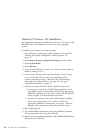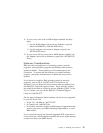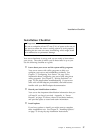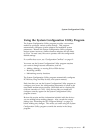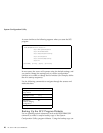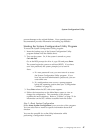Setup Program
If your server came with a network adapter, use the
network-adapter configuration program to configure and test the
network adapter. Follow the instructions in your network-adapter
documentation. If your server came with a RAID adapter
preinstalled, refer to the RAID adapter documentation for
configuration information.
Using the Setup Program
The Setup program stores configuration values in nonvolatile
random-access memory (NVRAM) and in the battery-backed
memory of the real-time clock. Entries that you make in the System
Configuration Utility program overwrite the entries made in the
Setup program.
You perform much of the system configuration through the System
Configuration Utility program, not the Setup program. Because the
System Configuration Utility program resides on diskette, you must
enable the diskette drive before using the System Configuration
Utility. After configuring the system, you might prefer to secure it
against casual or unauthorized access by running the Setup program
to disable the diskette drive.
In most cases, the server operates using the default settings, and
you need to change the settings only to resolve configuration
conflicts or to enable or change device function (for example,
defining diskette drive types).
Review this section and the information that came with the device
before making changes. Also, record the current settings (see
“Recording and Restoring Default Settings” on page 43) before
making any changes.
Changing Settings
You can advance through the screens by pressing the Page Up
(PgUp) or Page Down (PgDn) key. Use the Up Arrow (↑) or Down
Arrow (↓) key to advance through the items on the screen. Change
selections by first advancing to the item that you want to change;
then, use the plus key (+) or minus key (−) to make the change.
Chapter 3. Configuring Your Server 41




